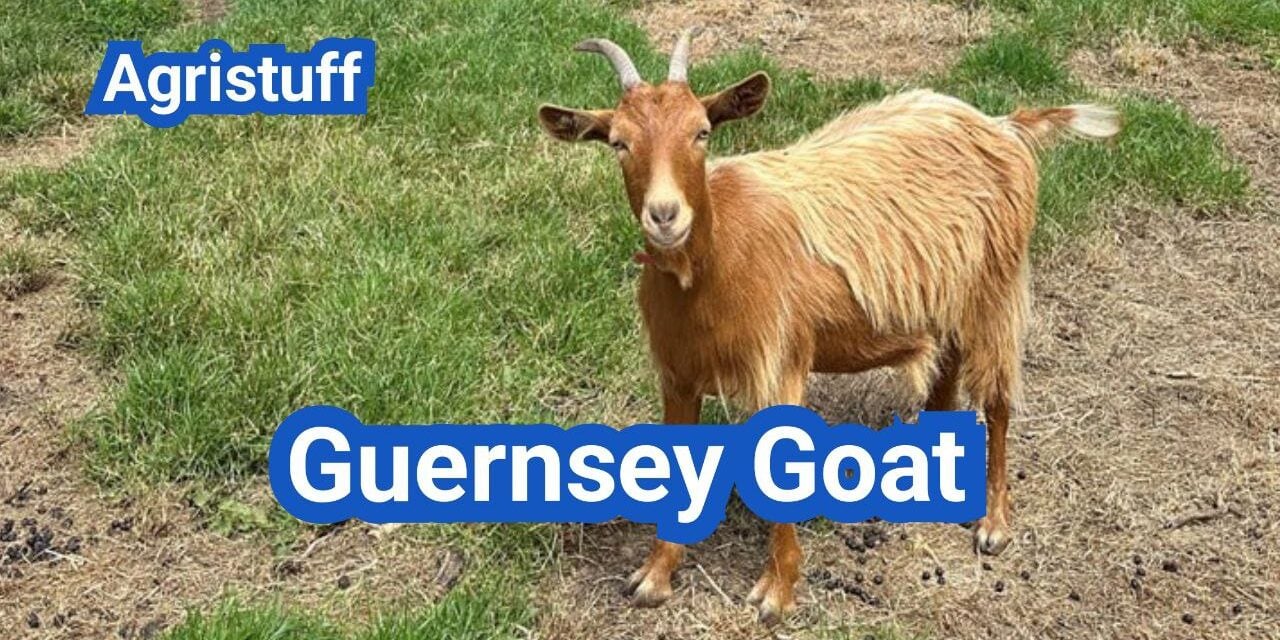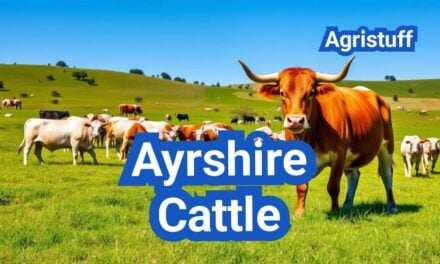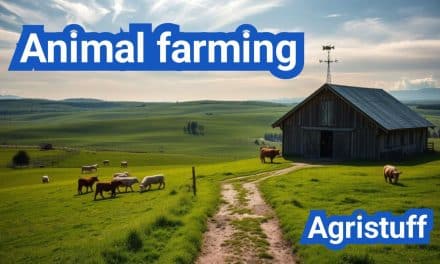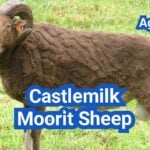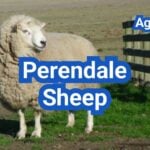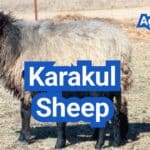The Guernsey Goat is an ancient breed known for its distinctive golden coat and high milk production.
Originating from the Channel Islands, this breed has a rich history that spans centuries. The characteristics of the Guernsey Goat make it a popular choice among dairy farmers.
Understanding the history, origin, and characteristics of this breed is essential for appreciating its value in dairy production.
Key Takeaways
- The Guernsey Goat is known for its high milk production.
- This breed has a distinctive golden coat.
- Originating from the Channel Islands, it has a rich history.
- The Guernsey Goat is a popular choice among dairy farmers.
- Its characteristics make it valuable for dairy production.
The Fascinating World of the Guernsey Goat
With its rich history and unique characteristics, the Guernsey Goat stands out among dairy goat breeds. Originating from the Channel Islands, this breed has evolved over centuries to become a favorite among dairy farmers, particularly those operating small farms.
Overview of This Unique Breed
The Guernsey Goat is renowned for its high milk production and friendly temperament. These goats are relatively small in size compared to other dairy breeds, making them an ideal choice for small-scale dairy farming. Key characteristics include:
- Rich milk with high butterfat content, ideal for cheese and butter production
- Friendly and docile nature, making them easy to handle
- Hardy and adaptable to various climates
- Efficient milk producers with a relatively low feed requirement
Why Guernsey Goats Are Gaining Popularity
In recent years, Guernsey Goats have been gaining popularity due to their numerous benefits. Some of the reasons include:
- Their milk is rich in quality and quantity, making it perfect for dairy products.
- Their friendly nature makes them suitable for farms with limited labor.
- They are adaptable to different farming systems, from small homesteads to larger commercial operations.
As the demand for high-quality dairy products continues to rise, the Guernsey Goat is poised to play a significant role in the dairy farming industry, especially among small farms looking to diversify their products.
History and Heritage of Guernsey Goats

Originating in the Channel Islands, the Guernsey Goat has a storied past that is worth exploring. The breed’s history is deeply rooted in the islands’ agricultural practices and the need for a hardy, productive dairy goat.
Ancient Origins on the Channel Islands
The Channel Islands, located off the coast of Normandy, France, have a unique agricultural heritage that dates back centuries. The Guernsey Goat is believed to have descended from ancient goat breeds brought to the islands by monks and settlers. The harsh island environment necessitated the development of a robust and adaptable breed, capable of thriving in challenging conditions.
Over time, the Guernsey Goat evolved into a distinct breed, known for its rich milk and hardy constitution. The breed’s development was influenced by the islands’ limited resources and the need for self-sufficiency in dairy production. The result was a goat that was not only productive but also well-suited to the local climate.
Development Through the Centuries
As the centuries passed, the Guernsey Goat continued to evolve, shaped by the agricultural practices and selective breeding practices of the islanders. The breed was refined to enhance its dairy characteristics, resulting in the high-quality milk that Guernsey Goats are known for today. Selective breeding programs played a crucial role in developing the breed’s distinctive traits.
The Guernsey Goat’s heritage as a dairy breed is a testament to the ingenuity of the islanders who developed it. Today, the breed is recognized worldwide for its rich milk and is considered one of the heritage dairy goat breeds worth preserving.
Guernsey Goat Varieties and Classifications
Among the Guernsey goat breed, various classifications have been established, reflecting their adaptability and distinct traits. The Guernsey goat has evolved into several recognized varieties, each with its own set of characteristics.
Golden Guernsey
The Golden Guernsey is one of the most well-known varieties, cherished for its rich golden coat and high milk production. This variety is a result of careful breeding practices that have enhanced its desirable traits.
Royal Golden Guernsey
The Royal Golden Guernsey is a prestigious variety, distinguished by its exceptional quality and royal lineage. It represents the pinnacle of Guernsey goat breeding, with a focus on superior genetics and milk production capabilities.
British Guernsey
The British Guernsey variety is recognized for its robust health and productivity. This variety has been developed with a focus on hardiness and adaptability to different environments.
American Guernsey
The American Guernsey Dairy Goat is a popular variety in the United States, known for its high milk yield and quality. American Guernsey goats are bred to thrive in various conditions, making them a favorite among dairy farmers.
| Variety | Key Characteristics | Milk Production |
|---|---|---|
| Golden Guernsey | Rich golden coat, high milk production | High |
| Royal Golden Guernsey | Exceptional quality, royal lineage | Very High |
| British Guernsey | Robust health, productivity | High |
| American Guernsey | High milk yield, quality | Very High |
Each of these varieties contributes to the rich diversity within the Guernsey goat breed, offering unique advantages for breeders and dairy farmers. Understanding these classifications is essential for appreciating the breed’s complexity and potential.
Physical Characteristics and Breed Standards

The Guernsey Goat is renowned for its striking appearance and robust build. This breed is known for its rich golden coat, which is one of its most distinctive features.
Size and Weight Specifications
Guernsey Goats are considered a medium-sized breed. Does typically weigh between 120 and 150 pounds, while bucks can weigh up to 180 pounds.
| Category | Weight Range (lbs) | Height Range (inches) |
|---|---|---|
| Does | 120-150 | 30-36 |
| Bucks | 150-180 | 32-40 |
Coat Colors and Patterns
The Guernsey Goat’s coat is characterized by its golden color, which can range from a light fawn to a deep red-gold. The coat is typically smooth and glossy.
The breed standard allows for some white markings, but the overall impression should be one of a solid golden color.
Distinctive Physical Features
Guernsey Goats have a number of distinctive physical features, including their prominent ears and robust build. Their eyes are typically a bright, alert brown.
The breed is also known for its well-developed udder in does, which is an important consideration for dairy production.
Temperament and Behavioral Traits
Guernsey Goats are known for their exceptional temperament, which combines docility with a playful spirit, making them a joy to be around. Their friendly and outgoing nature makes them highly sociable and interactive, not just with humans but also with other animals.
Personality Profile
The personality profile of Guernsey Goats is characterized by their calm and gentle disposition. They are known to be curious and friendly, often approaching humans for interaction. This breed is highly intelligent and can be trained to perform various tasks and behaviors.
- They are known for their affectionate nature, often seeking human interaction.
- Guernsey Goats are generally easy-going and can adapt to various living conditions.
- Their intelligence makes them trainable for tasks such as walking on a leash or responding to commands.
Social Behavior with Other Animals
Guernsey Goats are social creatures that thrive in the company of other animals. They are known to form close bonds with other goats and can also get along well with other livestock such as sheep and cattle.
Key aspects of their social behavior include:
- They establish a hierarchy within their group, with dominant goats leading the way.
- Guernsey Goats are known to be protective of their herd members, showing a strong sense of loyalty.
- They communicate effectively through a variety of vocalizations and body language.
Interaction with Humans
The interaction between Guernsey Goats and humans is generally very positive. Their friendly and docile nature makes them an excellent choice for farms and homesteads where they are handled regularly.
Benefits of their interaction with humans include:
- They are easy to handle and manage, even for inexperienced handlers.
- Guernsey Goats can become quite affectionate, enjoying the company of humans and often seeking it out.
- Their calm nature makes them less likely to be aggressive or difficult to manage.
How to Set Up Your Guernsey Goat Farm

For those looking to venture into dairy farming, setting up a Guernsey Goat farm is an exciting endeavor that demands careful consideration of several key factors. The success of your farm depends on meticulous planning and a thorough understanding of the land, equipment, and supplies needed.
Land Requirements and Considerations
The first step in establishing a Guernsey Goat farm is to assess your land. Guernsey Goats require adequate space for grazing and exercise. A general rule of thumb is to allocate about 1/4 to 1/2 acre per goat, depending on the quality of the pasture.
The land should also be well-drained and fenced to prevent escape and predator entry. Consider the topography and climate of your area, as Guernsey Goats are adaptable but perform best in temperate climates.
Essential Equipment and Supplies
Once you have suitable land, you’ll need to acquire the necessary equipment and supplies. This includes:
- Fencing materials to secure your land
- Goat shelters or barns for protection against the elements
- Feeding equipment, such as hay feeders and water buckets
- Milking equipment, if you plan to produce dairy products
- Health supplies, including vaccinations and parasite control measures
Investing in quality equipment will help ensure the health and productivity of your Guernsey Goats.
Initial Investment Breakdown
Understanding the initial investment required is crucial for planning. Here’s a breakdown of the typical costs involved in setting up a Guernsey Goat farm:
| Category | Cost per Unit | Quantity | Total Cost |
|---|---|---|---|
| Land Preparation | $500 | 1 | $500 |
| Fencing | $3 per foot | 1000 feet | $3000 |
| Goat Shelters | $1000 | 1 | $1000 |
| Feeding Equipment | $50 | 10 | $500 |
| Initial Goat Purchase (5 goats) | $200 | 5 | $1000 |
| Total | $6000 |
The initial investment for a Guernsey Goat farm can vary widely based on factors like land cost, the number of goats, and equipment quality. However, this table provides a general estimate to help you plan.
Building Proper Housing for Guernsey Goats

To ensure the well-being of Guernsey Goats, it’s vital to construct housing that meets their specific needs. Proper housing is essential for protecting these animals from harsh weather conditions and predators, while also ensuring their overall health and productivity.
Shelter Design and Requirements
The shelter for Guernsey Goats should be designed with ventilation in mind to prevent the buildup of ammonia from their waste. Adequate ventilation helps in maintaining a healthy environment. The shelter should also be dry and draft-free. A simple, three-sided shelter can be an effective and cost-efficient option.
“A well-designed shelter is crucial for the health of Guernsey Goats,” says Jane Smith, a renowned goat breeder. “It protects them from extreme weather and provides a comfortable space for rest.”
Fencing Specifications
Fencing is a critical aspect of Guernsey Goat housing. The fence should be at least 5 feet tall to prevent escape and predator entry. High-tensile wire or woven wire fencing is recommended due to its durability and effectiveness. The fencing material should be sturdy enough to withstand the goats’ tendency to lean or rub against it.
- Use high-tensile or woven wire fencing.
- Ensure the fence is at least 5 feet tall.
- Regularly inspect the fence for damages.
Creating Comfortable Living Spaces
Creating comfortable living spaces for Guernsey Goats involves more than just shelter and fencing. The living area should be clean, dry, and well-ventilated. Providing adequate bedding, such as straw or sand, helps keep the area dry and comfortable. Additionally, ensuring enough space for the goats to move around is crucial for their well-being.
Key considerations for comfortable living spaces include:
| Aspect | Description |
|---|---|
| Cleanliness | Regular cleaning of the living area. |
| Dryness | Ensuring the area remains dry. |
| Ventilation | Adequate airflow to prevent ammonia buildup. |
By focusing on these aspects, farmers can create a healthy and productive environment for their Guernsey Goats, ultimately enhancing their overall welfare and milk production capabilities.
Comprehensive Nutrition and Feeding Guide

A comprehensive nutrition plan is essential for Guernsey goat farmers to ensure the health and productivity of their herd. Guernsey goats, known for their rich milk production, require a balanced diet that supports their nutritional needs.
Basic Dietary Requirements
Guernsey goats need a diet rich in fiber, with a mix of high-quality hay, grass, and grains. The basic dietary requirements include:
- High-quality hay (legume or grass hay)
- Fresh water at all times
- Grains for energy (such as oats, barley, or corn)
- Minerals and vitamins supplements
Nutritional Balance is crucial. A diet lacking in essential nutrients can lead to health issues and decreased milk production. Ensuring the right balance involves understanding the nutritional content of the feed and adjusting as necessary.
Specialized Nutrition for Dairy Production
For Guernsey goats used in dairy production, specialized nutrition is key to maximizing milk yield and quality. This includes:
- Increasing the proportion of grains in the diet during lactation
- Ensuring adequate protein intake for milk production
- Providing calcium and phosphorus for strong bone health
Adjusting the diet according to the stage of lactation is important. For instance, during peak lactation, the energy requirements are higher, necessitating an adjustment in the feeding regimen.
Creating a Feeding Schedule
A well-planned feeding schedule is vital for maintaining the health and productivity of Guernsey goats. This involves:
- Dividing the daily ration into multiple feedings
- Ensuring consistency in feeding times
- Monitoring the goats’ response to the diet and making adjustments as needed
Monitoring the health and production levels of the goats in response to the feeding schedule is crucial. Adjustments may be necessary based on factors like age, health status, and production level.
Step-by-Step Breeding Guide for Guernsey Goats
To successfully breed Guernsey Goats, one must consider several critical factors, including the health and pedigree of the breeding stock. Breeding Guernsey Goats requires a comprehensive understanding of their breeding cycles, genetic qualities, and the techniques involved in mating.
Selecting Quality Breeding Stock
Selecting the right breeding stock is the foundation of a successful Guernsey Goat breeding program. High-quality breeding stock should exhibit excellent physical characteristics, robust health, and a strong pedigree. When evaluating potential breeding animals, consider their genetic background, milk production capabilities, and overall temperament.
The ideal breeding stock should be free from genetic disorders and have a history of good health. It’s also crucial to assess their conformation and ensure they meet the breed standards for Guernsey Goats.
| Characteristics | Ideal Traits |
|---|---|
| Health | Free from genetic disorders, robust overall health |
| Pedigree | Strong genetic background, high milk production lineage |
| Temperament | Docile, friendly, and easy to handle |
Understanding Breeding Cycles
Guernsey Goats are seasonal breeders, with the breeding season typically occurring in the fall. Understanding the estrus cycle and being able to identify when a doe is in heat is crucial for successful breeding. The estrus cycle in Guernsey Goats lasts approximately 18-24 days, with the doe being receptive to breeding for about 24-36 hours during this cycle.
Monitoring the breeding cycle closely allows breeders to plan matings effectively and predict kidding dates. This knowledge is essential for managing the breeding program and ensuring the health and well-being of both the doe and the kids.
Mating Procedures and Techniques
The mating process for Guernsey Goats can be managed through either natural mating or artificial insemination (AI). Natural mating involves introducing the doe to a selected buck, while AI offers more control over the genetic material being introduced into the herd.
Regardless of the method chosen, it’s essential to ensure that both the doe and the buck are healthy and free from diseases. Proper mating techniques and careful observation during the breeding process are critical to achieving successful pregnancies.
By following these guidelines and understanding the intricacies of Guernsey Goat breeding, breeders can improve the quality and productivity of their herd.
Pregnancy and Kidding Management

Pregnancy and kidding management are vital components of Guernsey goat breeding, impacting both the doe and kid’s health. Effective management during these critical periods ensures the well-being of the animals and the success of the breeding program.
Pregnancy Care Timeline
A well-planned pregnancy care timeline is essential for the health of the doe and the developing kids. During the first 100 days of gestation, it’s crucial to maintain a balanced diet that meets the doe’s nutritional needs without overfeeding. As the pregnancy advances, particularly in the last trimester, the nutritional requirements increase significantly.
Nutritional adjustments should be made to support the doe’s health and the growth of the kids. Regular veterinary check-ups are also vital during this period to monitor the health of the doe and detect any potential issues early.
Preparing for Birth
Preparing for kidding involves several steps, including ensuring the kidding area is clean, safe, and easily accessible. The kidding pen should be well-bedded and equipped with necessary supplies such as clean towels, iodine for navel treatment, and a kid warmer if necessary.
It’s also important to monitor the doe closely as she approaches her kidding date. Signs of impending kidding include restlessness, pawing at the ground, and a swollen udder. Being present during kidding can help identify any complications early, ensuring timely intervention.
Kidding Process and Assistance
The kidding process typically occurs without major complications if the doe is healthy and well-managed. However, being prepared to assist is crucial. Knowing the normal presentation of kids and being able to identify malpresentation can help in providing necessary assistance.
In cases where assistance is required, it’s essential to follow proper hygiene practices to minimize the risk of infection. This includes washing hands thoroughly and using clean equipment. If complications arise, seeking veterinary assistance is often the best course of action to ensure the health and safety of both the doe and the kids.
By focusing on these aspects of pregnancy and kidding management, Guernsey goat breeders can significantly improve the outcomes of their breeding programs, enhancing both the health of their animals and the overall success of their operations.
Health Management and Disease Prevention
Effective disease prevention is key to a successful Guernsey goat dairy operation. Maintaining the health of these goats is not only crucial for their wellbeing but also directly impacts the quality and quantity of milk produced.
Common Health Issues in Guernsey Goats
Guernsey goats are generally hardy, but like all breeds, they are susceptible to certain health issues. Common problems include parasites, both internal and external, mastitis, and nutritional deficiencies.
Parasites are a significant concern, as they can lead to a range of issues from weight loss to anemia. Regular monitoring and appropriate treatment are essential.
Preventative Care Schedule
A preventative care schedule is vital for maintaining the health of Guernsey goats. This includes regular vaccinations, parasite control measures, and hoof care.
| Procedure | Frequency | Purpose |
|---|---|---|
| Vaccinations | Annually | Protect against diseases |
| Parasite Control | Quarterly | Manage internal and external parasites |
| Hoof Trimming | Every 6-8 weeks | Prevent hoof-related issues |
Vaccination Protocols
Vaccination protocols for Guernsey goats should be tailored to the specific needs of the herd, considering factors like location and disease prevalence. Common vaccinations include those for Clostridium and Booster shots.
Consulting with a veterinarian to develop a customized vaccination plan is recommended to ensure the health and wellbeing of the goats.
Maximizing Milk Production from Guernsey Goats

The Guernsey breed is celebrated for its rich milk, and optimizing its production involves careful consideration of several factors. Guernsey goats are known for their high milk production, and proper milking techniques and equipment are essential to maximizing milk quality and quantity.
Milking Techniques and Equipment
Effective milking practices are crucial for achieving high milk yields from Guernsey goats. This includes using the right milking equipment and adopting techniques that minimize stress on the animals. Some key considerations include:
- Using milking machines that are designed for goat milk production
- Implementing a consistent milking schedule
- Ensuring the milking area is clean and hygienic
- Handling the goats gently to reduce stress
Proper milking techniques not only enhance milk production but also contribute to the overall health and well-being of the goats. Regular maintenance of milking equipment is also vital to prevent bacterial contamination and ensure the quality of the milk.
Milk Quality Characteristics
Guernsey goat milk is renowned for its rich flavor and high nutritional value. The quality of the milk is influenced by factors such as the goat’s diet, milking practices, and health. Key characteristics of high-quality Guernsey goat milk include:
- High butterfat content
- Rich protein content
- Excellent nutritional profile
Maintaining high milk quality is essential for dairy farmers who wish to produce premium products. This involves not only proper milking techniques but also careful management of the goats’ diet and health.
Production Volume Expectations
The average milk production per Guernsey goat can vary based on factors such as genetics, nutrition, and management practices. Generally, a well-managed Guernsey goat can produce between 1,000 to 2,000 pounds of milk per year. Understanding these expectations is crucial for dairy farmers to plan their operations effectively.
By focusing on optimal milking practices and proper goat care, dairy farmers can maximize their milk production and maintain the high quality that Guernsey goat milk is known for.
Creating Artisanal Products from Guernsey Goat Milk
Guernsey Goat milk is renowned for its rich flavor and nutritional benefits, making it an ideal choice for producing artisanal dairy products. The unique characteristics of this milk allow for the creation of a wide range of high-quality goods that are increasingly in demand.
Cheesemaking Basics
Cheesemaking is a traditional craft that involves transforming milk into a variety of cheeses through fermentation and coagulation. Guernsey Goat milk is particularly well-suited for cheesemaking due to its fat content and rich flavor profile. To start, one must first prepare the milk by pasteurizing it, then adding a starter culture to initiate fermentation.
The next step involves adding rennet to coagulate the milk, followed by curdling and shaping the curds into the desired form. The cheese is then aged to develop its characteristic flavor and texture. Proper temperature and humidity control are crucial during the aging process to ensure the quality of the final product.
Yogurt and Other Dairy Products
In addition to cheese, Guernsey Goat milk can be used to produce other artisanal dairy products such as yogurt, butter, and ice cream. Yogurt production involves heating the milk to a specific temperature, then cooling it before adding a yogurt culture. The mixture is then incubated until it thickens and develops the desired tanginess.
Other dairy products like butter and ice cream can also be crafted using Guernsey Goat milk, each requiring specific techniques and equipment. For instance, churning cream produces butter, while combining milk with cream and sugar, then freezing it, results in ice cream.
Marketing Your Guernsey Goat Products
Once your artisanal dairy products are ready, effective marketing is key to reaching potential customers. Highlighting the unique qualities of Guernsey Goat milk and the care that goes into producing these goods can help differentiate your products in a competitive market.
Utilizing online platforms, participating in local farmers’ markets, and collaborating with gourmet food establishments are effective strategies for promoting your products. Building a strong brand identity and engaging with your customer base can also foster loyalty and drive sales.
Guernsey Goats in the United States
The Guernsey goat breed has a rich history in the United States, dating back to its initial importation. The introduction of Guernsey goats to America marked a significant milestone in the country’s dairy industry, as they brought with them unique characteristics that would enhance local dairy farming.
History of Importation and Development
Guernsey goats were first imported into the USA to improve dairy production. The breed’s high milk yield and rich milk quality made it an attractive choice for American dairy farmers. Over the years, the breed has been developed and refined through careful breeding practices.
The American Guernsey Association played a crucial role in promoting the breed and maintaining its standards. As recorded, “The Guernsey breed has been a mainstay in American dairy farming, known for its efficiency and productivity.”
Current Population and Distribution
Today, Guernsey goats can be found across the United States, with a notable presence in areas known for their dairy farming traditions. The current population is a testament to the breed’s adaptability and the ongoing demand for high-quality dairy products.
- The breed is particularly popular in regions with a strong agricultural heritage.
- Guernsey goats are valued for their milk production and are often used in small-scale dairy farming operations.
Notable Farms and Success Stories
Several farms across the U.S. have achieved significant success with Guernsey goats. For instance, a farm in Wisconsin has been recognized for its innovative approach to dairy farming using Guernsey goats, stating, “Our Guernsey goats have been instrumental in our success, providing us with high-quality milk that our customers love.”
“The Guernsey goat is a breed that truly stands out for its dairy production capabilities and its friendly nature,” said Jane Smith, a renowned dairy farmer.
These success stories highlight the potential of Guernsey goats in American dairy farming and their contribution to the industry’s continued growth and innovation.
Finding and Purchasing Quality Guernsey Goats
The process of purchasing a Guernsey goat involves several key steps to ensure you’re getting a healthy and high-quality animal. Whether you’re a seasoned breeder or a newcomer to the world of Guernsey goats, understanding the intricacies of the buying process is crucial.
Locating Reputable Breeders
Finding a reputable Guernsey goat breeder is the first step in acquiring a quality animal. Guernsey Goat Breeders USA can be found through various channels, including breed associations, online directories, and agricultural events. It’s essential to research potential breeders thoroughly, looking for those who are transparent about their breeding practices, animal health, and genetic testing.
One effective way to locate reputable breeders is by attending Guernsey goat shows and events, where you can meet breeders in person, see the animals, and ask questions. Additionally, joining online forums and social media groups dedicated to Guernsey goat enthusiasts can provide valuable insights and recommendations.
What to Look for When Buying
When purchasing a Guernsey goat, there are several factors to consider to ensure you’re getting a healthy and high-quality animal. Start by examining the goat’s overall health, looking for signs of illness or injury. Check the animal’s vaccination records and ensure they’ve been properly cared for.
- Evaluate the goat’s conformation and breed characteristics.
- Review the animal’s production records, if applicable.
- Ask about genetic testing and the breeder’s breeding program.
It’s also crucial to assess the breeder’s reputation and after-sales support. A reputable breeder will provide guidance on caring for your new Guernsey goat and be available to answer questions.
Average Costs and Considerations
The cost of purchasing a Guernsey goat can vary widely depending on factors such as the animal’s age, quality, and breeding potential. On average, you can expect to pay between $500 and $2,000 for a Guernsey goat, with high-quality breeding stock commanding higher prices.
| Category | Average Cost |
|---|---|
| Purebred Guernsey Doe | $800 – $1,200 |
| Breeding Buck | $1,000 – $2,000 |
In addition to the initial purchase price, consider the ongoing costs of caring for your Guernsey goat, including feed, veterinary care, and equipment.
Organizations and Resources for Guernsey Goat Owners
The Guernsey goat community is supported by several key organizations that provide valuable resources. These organizations play a crucial role in promoting the breed, providing education, and facilitating networking among breeders and owners.
Guernsey Goat Breeders of America
The Guernsey Goat Breeders of America is a prominent organization dedicated to the promotion and preservation of the Guernsey goat breed. They provide breeders with resources for registration, breeding guidance, and marketing support. By joining this organization, breeders can access a wealth of knowledge and network with other experienced breeders.
Guernsey Goat Society
The Guernsey Goat Society is another vital organization that works closely with breeders to advance the interests of Guernsey goat owners. Their activities include maintaining breed standards, organizing events, and publishing relevant literature. Membership in the society offers numerous benefits, including access to exclusive events and opportunities to participate in breed development programs.
Shows, Events, and Networking Opportunities
Participating in shows, events, and networking opportunities is an excellent way for Guernsey goat owners to showcase their animals, learn from others, and stay updated on the latest developments in the breed. These events range from local agricultural shows to national breed conferences, providing a platform for breeders to connect and share knowledge.
Guernsey goat owners can greatly benefit from engaging with these organizations and participating in the various events they host. By doing so, they not only enhance their knowledge and skills but also contribute to the overall growth and development of the Guernsey goat community.
At The End of: Guernsey Goat Breeding
The Guernsey Goat is a unique and valuable breed, gaining popularity among dairy farmers and small-scale producers in the United States. With their rich history, distinct physical characteristics, and high-quality milk production, it’s no wonder that Guernsey Goats are becoming a sought-after choice for those in the dairy industry.
As discussed throughout this article, Guernsey Goats offer a range of benefits, from their friendly temperament to their versatility in producing artisanal dairy products. Whether you’re a seasoned dairy farmer or just starting out, the Guernsey Goat is definitely worth considering for your farm.
In conclusion, the Guernsey Goat is a breed that is sure to continue growing in popularity. With the right care, management, and breeding practices, these goats can provide a valuable source of income and a fulfilling experience for farmers and producers.
FAQ
What is the origin of the Guernsey Goat breed?
The Guernsey Goat breed originated from the Channel Islands, specifically from Guernsey Island.
What are the characteristics of Guernsey Goats?
Guernsey Goats are known for their rich milk production, friendly temperament, and distinctive golden coat color.
What is the average milk production of Guernsey Goats?
Guernsey Goats are known for their high milk production, with an average yield of around 1,000-2,000 pounds per year.
How do I care for my Guernsey Goats?
Guernsey Goats require proper housing, nutrition, and health care, including regular vaccinations and parasite control.
What are the benefits of raising Guernsey Goats for dairy production?
Guernsey Goats are ideal for dairy production due to their high milk yield, rich milk composition, and friendly temperament.
Can Guernsey Goats be used for purposes other than dairy production?
Yes, Guernsey Goats can be used for meat production, land management, and as pets.
How do I breed Guernsey Goats?
Breeding Guernsey Goats requires selecting quality breeding stock, understanding breeding cycles, and following proper mating procedures.
What are the common health issues in Guernsey Goats?
Common health issues in Guernsey Goats include parasites, mastitis, and reproductive problems, which can be prevented with proper care and management.
Where can I find Guernsey Goat breeders?
You can find Guernsey Goat breeders through the Guernsey Goat Breeders of America or local breed associations.
What are the benefits of joining a Guernsey Goat breed association?
Joining a Guernsey Goat breed association provides access to resources, networking opportunities, and support for breeders and owners.
Conclusion of: Guernsey Goat Breed
Introduction to Guernsey Goat
The Guernsey Goat is a rare golden dairy goat breed that appeals to homesteaders, small farms, and specialty dairies that want rich milk, calm temperaments, and striking looks in the pasture. Originating from the island of Guernsey in the English Channel, the Guernsey Goat (including Golden, British, and American Guernsey lines) is known for efficient milk production and high butterfat that makes cheese and yogurt especially creamy.
For farmers in the United States, the Guernsey Goat offers a niche alternative to more common dairy breeds such as Alpine or Nubian, combining solid yields with relatively modest feed needs and a gentle character. Because the Guernsey Goat is still considered a minority breed, raising it can support conservation work while giving your farm a unique marketing story based on heritage genetics and golden-colored animals. Learn more about the Guernsey Goat from Guernsey Goat Breeders of America
History and Origin of Guernsey Goat
The modern Guernsey Goat traces its roots back more than two centuries to golden-colored goats on the island of Guernsey, where they grazed hedgerows and rough pasture and were mentioned in local writings in the 1800s. Over time, island farmers selected these goats for milk production and golden coats, gradually shaping what became known as the Golden Guernsey. In the mid-1900s, careful breeding work and herd-book recording helped stabilize the type, and exports to mainland Britain supported the development of both the Golden Guernsey and the later British Guernsey, which blends Golden Guernsey genetics with other dairy breeds.
In the UK, the Golden Guernsey has been granted a Royal title and is officially known as the Royal Golden Guernsey Goat, underscoring the cultural and historical importance of the Guernsey Goat as a distinct dairy breed with island heritage. History of the Guernsey Goat from the British Goat Society
Guernsey Goat Types: Golden, British and American
When people talk about the Guernsey Goat, they may be referring to several closely related but distinct breed types: the Royal Golden Guernsey, the British Guernsey, and the American Guernsey dairy goat. The Royal Golden Guernsey is the original island-type Guernsey Goat and is registered as a pure breed in the British Goat Society herdbook.
The British Guernsey Goat was developed through controlled crossbreeding, often using Golden Guernsey bucks on Swiss and other dairy does to increase size and production while preserving the golden color and mild temperament. In North America, breeders created the American Guernsey Goat through a graded-up program using imported Golden Guernsey genetics so the Guernsey Goat could adapt to U.S. climates, management systems, and dairy markets. Together, these types preserve the golden look and dairy qualities of the Guernsey Goat while making the breed more practical for modern farms around the world. Royal Golden Guernsey Goat Society overview of Guernsey Goat types
Physical Characteristics of Guernsey Goat
The most striking feature of the Guernsey Goat is its golden coat, which can range from pale blond to deep bronze and often has a soft, silky texture. Official breed descriptions emphasize that the Royal Golden Guernsey Goat is usually finer-boned and somewhat smaller than many large Swiss dairy goats, with a graceful build, straight or slightly dished face, and erect ears.
Many Guernsey Goats are horned, although polled individuals also occur, and the coat may show lighter shading on the underside and darker fringes on the legs or along the back. This distinctive coloring makes the Guernsey Goat highly visible in the pasture, popular for farm visitors, and attractive in photographs and marketing materials. In addition to its golden coat, a good Guernsey Goat should display well-attached udders, strong feet and legs, and overall dairy character that supports productive lactations. Physical characteristics of the Golden Guernsey Goat at Oklahoma State University
Milk Production and Composition in Guernsey Goat
The Guernsey Goat is not typically bred for record-breaking milk volume, but for quality and efficiency. Most sources describe the Golden or Royal Golden Guernsey Goat as a moderate producer, often yielding around 2–3 liters (roughly 4–5 pints) of milk per day under good management.
What the Guernsey Goat may lack in sheer volume, it often makes up for in milk composition, with relatively high butterfat and protein content. This richer milk is especially valuable for farmstead cheesemaking, yogurt, ice cream, and other value-added products where solids content has a big impact on texture and yield. Because the Guernsey Goat tends to be a thrifty animal with a smaller frame than some large dairy breeds, it can convert feed into milk efficiently, which is an advantage when feed costs are high. For U.S. dairies, the Guernsey Goat can therefore fit nicely into small-scale, high-quality dairy operations. Golden Guernsey Goat production information from Rare Breeds Survival Trust
Temperament and Behavior of Guernsey Goat
Temperament is one of the reasons many people fall in love with the Guernsey Goat. Breed organizations consistently describe Guernsey Goats as calm, friendly, and well suited to small farms and family settings. The Royal Golden Guernsey Goat in particular is often recommended as a good “household goat” because it typically handles quietly and bonds well with people. For new goat keepers in the USA, a gentle Guernsey Goat can make daily chores such as milking, hoof trimming, and health checks far less stressful.
This temperament also helps when the Guernsey Goat is used in agritourism, educational programs, or 4-H projects where visitors and children may interact with the animals. While individual personalities vary, responsible breeders of the Guernsey Goat actively select for good manners and easy handling along with productive dairy traits. Guernsey Goat temperament details from Guernsey Goat Breeders of America
Adaptation, Climate and Grazing Habits of Guernsey Goat
The island background of the Guernsey Goat has shaped a breed that is adaptable yet particularly comfortable in mild, damp climates with access to browse and mixed pasture. Historically, Golden Guernsey Goats grazed and browsed on the rocky, windswept island of Guernsey, feeding on hedgerows, shrubs, and rough vegetation rather than only on lush, improved pasture.
This browsing habit makes the Guernsey Goat a useful partner in rotational grazing systems, where goats are used to control brush and weeds while cattle or sheep focus on grasses. In the United States, the Guernsey Goat can do well in many regions when provided with good shelter, dry footing, and protection from extreme heat and cold. Shade, plenty of fresh water, and well-designed fencing help the Guernsey Goat stay comfortable and productive in both humid and semi-arid environments. Farm-level insight into Royal Golden Guernsey Goat adaptation
Housing and General Management for Guernsey Goat
Good housing and day-to-day management are essential for keeping the Guernsey Goat healthy and productive. Dairy goat housing guidelines from U.S. extension services emphasize that while goats can tolerate cool temperatures, they need dry, draft-free shelters and adequate space to lie down comfortably. A typical arrangement for a small herd of Guernsey Goat does might include a three-sided shed or well-ventilated barn with deep bedding, secure fencing, and easy access to outdoor runs or pasture.
Cleanliness is critical; damp or dirty bedding can promote foot rot, parasite problems, and udder infections in any Guernsey Goat herd. Milking areas should be kept especially clean to protect milk quality and reduce mastitis risk. Simple features like sturdy gates, safe latches, and well-designed handling alleys can make routine tasks much easier when managing Guernsey Goat does, bucks, and kids. Housing facilities guidance for dairy goats from Alabama Cooperative Extension
Feeding and Nutrition of Guernsey Goat
Nutrition is the largest ongoing expense for any Guernsey Goat herd and has a direct impact on milk production, fertility, and general health. Extension nutrition guides recommend that all dairy goats, including the Guernsey Goat, receive high-quality forage as the foundation of the diet: good pasture, hay, or browse should make up most of what they eat. Lactating Guernsey Goat does often need additional energy and protein from grain or commercial dairy goat rations, especially in early lactation.
Balanced minerals are also important; a loose mineral mix formulated specifically for goats should be available free-choice to every Guernsey Goat in the herd. Clean water, accessible at all times, is essential for maintaining milk yield. Working with a local extension agent or livestock nutritionist can help you design a ration that fits your forage resources and supports the performance of your Guernsey Goat herd. Goat nutrition basics from the Extension Foundation
Health, Disease Prevention and Welfare in Guernsey Goat
A well-planned herd-health program is crucial for the Guernsey Goat, just as it is for any dairy breed. Goats are prone to internal parasites, hoof problems, mastitis, and infectious diseases if they are not managed carefully. Extension resources on dairy goat health recommend integrated parasite control for every Guernsey Goat herd, including pasture rotation, fecal monitoring, and targeted deworming instead of frequent blanket treatments.
Regular hoof trimming helps prevent lameness, while clean bedding and correct milking procedures reduce udder infections that can cut into a Guernsey Goat’s productive life. Vaccination protocols should be developed with a veterinarian based on local disease risks, and all Guernsey Goat owners should maintain good records of treatments, vaccinations, and production. Prompt attention to changes in appetite or behavior can often prevent small issues from turning into major health problems in Guernsey Goat herds. Herd health program for dairy goats from University of Arkansas Extension
Breeding, Kidding and Conservation of Guernsey Goat
Because the Guernsey Goat is still considered a rare or minority dairy breed, responsible breeding is about both farm profit and long-term conservation. Does should be bred only when they are mature, healthy, and in good body condition, typically around 12–18 months of age, and kidding should be timed to match forage availability and milk market needs. Careful selection for good udders, strong feet and legs, productive lactations, and calm temperament helps improve each generation of Guernsey Goat.
At the same time, breeders must avoid excessive inbreeding and keep a broad genetic base to protect the future of the breed. In North America, registration and breed standards for the Guernsey Goat are supported by organizations that work with the American Dairy Goat Association, helping to document pedigrees and maintain a clear identity for Guernsey lines. By joining these programs, each breeder contributes to the global conservation of the Guernsey Goat. ADGA rules and guidance for registering Guernsey dairy goats
Uses and Niche Markets for Guernsey Goat Products
The primary role of the Guernsey Goat is dairy production, but the breed’s unique characteristics open several niche market opportunities. High-component Guernsey Goat milk is excellent for artisan cheese, yogurt, kefir, and ice cream, where richer solids allow producers to charge premium prices. Some farms also use Guernsey Goat milk in soap and skincare products, which can be sold at farmers’ markets, online shops, or agritourism venues.
The eye-catching golden coat of the Guernsey Goat adds value to farm tours, open days, and educational events, helping farms build a recognizable brand centered on rare heritage livestock. Surplus males and cull animals can be used for meat on diversified farms, making the Guernsey Goat part of a broader mixed-enterprise system. With creative marketing, both the story and the products of the Guernsey Goat can distinguish a small dairy business in competitive local and regional markets. Example of farmstead products from Royal Golden Guernsey Goats
Guernsey Goat in the United States
Interest in the Guernsey Goat is growing among U.S. homesteaders, small dairies, and specialty cheese producers who want breeds that stand out. Because the Guernsey Goat is still relatively uncommon in many states, prospective buyers often rely on national breeder organizations and farm directories to find stock. These directories help match new owners with experienced breeders who are actively improving and preserving the Guernsey Goat through performance recording and thoughtful selection.
The rarity of the Guernsey Goat can be an advantage in marketing: products, tours, and educational programs that highlight the “golden dairy goat” story can attract customers who value heritage livestock and sustainable farming. By joining breed clubs, participating in milk tests or shows, and sharing data, U.S. breeders collectively strengthen the Guernsey Goat’s position in the American dairy goat landscape. Find Guernsey Goat farms in the U.S. via GGBoA directory
Is Guernsey Goat Right for Your Farm?
Deciding whether the Guernsey Goat is right for your farm starts with clarifying your goals. If your priority is very high milk volume for a large commercial dairy, you may lean toward more common Swiss breeds. However, if you prioritize rich milk, manageable size, gentle temperament, and a compelling heritage story, the Guernsey Goat is an excellent option. The breed fits particularly well on small farms and homesteads that value direct-to-consumer marketing, agritourism, or farmstead processing.
When evaluating the Guernsey Goat, consider your climate, forage resources, and access to breeding stock and veterinary support. With solid housing, nutrition, and health management, a small group of Guernsey Goat does can supply the household with milk and provide surplus for products or local sales while also contributing to the preservation of a rare golden dairy breed. Breed overview to help decide if the Golden Guernsey Goat suits your farm
Final thought
For farmers, homesteaders, and educators who value animals that are both productive and distinctive, the Guernsey Goat offers a rare combination of qualities. Its island history, its recognition as the Royal Golden Guernsey Goat, and its growing presence in Britain and North America create a rich narrative that can support powerful farm branding.
At the same time, the Guernsey Goat delivers practical benefits in the form of rich milk, moderate feed needs, and a generally gentle nature that suits family farms and agritourism settings. By investing in thoughtful management, responsible breeding, and creative marketing, you can make the Guernsey Goat the centerpiece of a sustainable dairy enterprise or educational program. Each new kid born on your farm becomes part of a global conservation effort that keeps the golden Guernsey Goat shining in pastures for future generations. Royal Golden Guernsey Goat Society – supporting the future of the Guernsey Goat
Sources & References
- Golden Guernsey Goats – Oklahoma State University, Breeds of Livestock
- Royal Golden Guernsey – British Goat Society
- Golden Guernsey – Rare Breeds Survival Trust
- Guernsey Goat Breeders of America – Official Site
- Housing & Facilities for Dairy Goats – Alabama Cooperative Extension
- Goat Nutrition – Extension Foundation
- Herd Health Program for Dairy Goats – University of Arkansas Extension
- ADGA – Guernsey Registration Rules
- Royal Golden Guernsey Goat Society
- Royal Golden Guernsey Goats – Cragg House Farm

